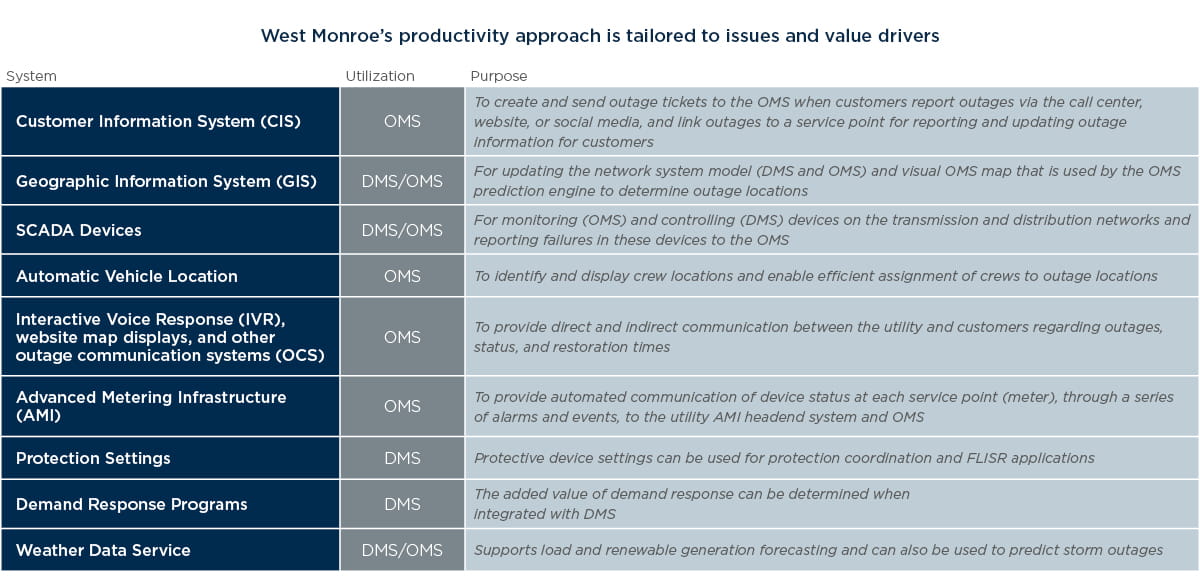
August 2018 | Resource
Advanced Distribution Management Systems (ADMS): The Core of the Utility of the Future
As grid modernization efforts continue, Advanced Distribution Management Systems (ADMS) are grabbing the attention of many electric utilities
Advanced Distribution Management Systems (ADMS): The Core of the Utility of the Future
Historically, utilities have leveraged a combination of their Outage Management System (OMS) and their Supervisory Control and Data Acquisition (SCADA) system as the center of operations for delivering power reliably to customers.
In more recent years, some utilities have begun to leverage a Distribution Management System (DMS) for grid planning and operations. In this article, we discuss the role of ADMS, as well as the when and how utilities are transitioning to the system. Understanding the opportunities provided by an ADMS enables utilities to better plan and prioritize implementation.
What is an ADMS?
The ideology of an ADMS is simple—a modular system with an OMS, DMS, and Distribution SCADA (D-SCADA) at its core (as depicted in Figure 1). However, we found that utilities and vendors use the term differently. To a utility, an ADMS is the aggregate system (at least one module addition to an OMS) to manage outages and operate the distribution system in a safe and efficient way.
To a vendor, what qualifies as an ADMS is less clear. When surveying vendors for examples of ADMS deployments during an OMS replacement project, multiple vendors claimed they each had an ADMS at the same utility. Regardless of definition, market reports such as those provided by Gartner no longer even produce OMS reports, only ADMS. This concludes that the grid management of the future is more advanced and automated than the past.
An ADMS is not a one-size-fits-all solution for utilities. Instead, utilities can purchase modules a la carte. This is a huge win for utilities and their customers as it allows for prioritized implementations with consideration to costs and benefits. Last year, we surveyed 14 electric utilities ranging in size from 50,000 to nearly 4 million customers. Of these utilities, three reported they already had an ADMS while nine were considering an ADMS. The most common modules purchased or under consideration were Volt VAR optimization (VVO) to implement conservation voltage reduction (CVR) and fault location, isolation, and restoration (FLISR). VVO/ CVR provides the opportunity to achieve reductions in energy consumption and peak demand while also reducing line losses. FLISR enables automated power restoration through automated fault finding and switching to reduce the number of customers interrupted and customer minutes of interruptions. Many additional modules are available, but the value of any module is dependent on an individual utility’s needs and current infrastructure.
Background and Utility System Integrations OMS
Background and utility system integrations OMS and most of its linked systems have been installed and in use at utilities across the country for many years, some linked together through internally developed integrations and some operated independently and linked manually by control room operators. The introduction of AMI and increased use of both distribution automation and communication of field device status has opened the door to a multitude of advanced capabilities and functionality for efficiently managing, maintaining, and restoring the grid. This ultimately enables improved reliability and resiliency for customers—the core of many grid modernization initiatives across the country.
At a typical utility, the OMS and DMS (if present) are integrated with several critical systems to manage outages, including identification, verification, restoration, and communication. Table 1 provides some of these linked systems and their respective purpose.
Table 1: Systems Traditionally Integrated with OMS and DMS
Why ADMS?
As outlined above, an ADMS provides benefits for both the utility and the customer. An ADMS with a good OMS at its core leads to faster restoration times through automation of the DMS, more efficient dispatching of crews during outages, and improved customer communications. Utilities with poor performance metrics (e.g., SAIDI, SAIFI, CAIDI), increasing distributed energy resources, and/or that have an OMS needing replacement or significant upgrades will find themselves evaluating an ADMS. However, with the expansive options that can come with an ADMS, costs can skyrocket.
Where to Start and How to Get There?
With the modularity of ADMS, it is critical to determine where your needs are and to evaluate the benefits and costs of relevant modules accordingly. An ADMS can quickly get very costly and require significant implementation effort. Here are our recommended steps:
- We first recommend conducting a current-state and future-state requirements assessment to help define scope and assist in the procurement process.
- Next, you can use this information to develop a high-level business case to select and prioritize investments keeping in mind budget and resources.
- After alignment with stakeholders, we recommend developing a roadmap to coordinate across other related utility initiatives. It is particularly important during this process to determine everything you need as part of your roadmap to get the most value out of your system. For example, conducting and/or verifying meter to transformer mapping improves the accuracy of outage management, allows for more accurate and informed switching plans, and enables transformer loading analyses.
In developing the roadmap, you may decide the first year or two will be for cleaning up the data, standing up the system, and getting core applications running. The following years could then be for more advanced applications such as FLISR and VVO according to costs and benefits. Other items for consideration when developing your business case and roadmap:
- The timing and cost to deploy devices in the field (load tap changers, voltage regulators, capacitor banks, line sensors)
- Telecommunications to field devices
- Resources to support implementation and ongoing operations of the ADMS
- Year by year rollout of feeders and substations to be included for VVO and FLISR
- Hybrid solutions—for example, using vendor off-the-shelf ADMS solution but integrating a stand-alone (separate vendor or homegrown) FLISR or VVO solution
- Utilize or replace/upgrade existing systems, such as OMS and EMS
After developing a roadmap, you can issue a request for information (RFI) to assist in developing a request for proposals (RFP). For developing the RFI/RFP identify:
- All the use cases, functional and technical requirements, architecture, and external systems that will need to be integrated with the ADMS. All stakeholders across the utility should be involved in this process (operators, engineers, security, IT, etc.)
- Issue the RFP to vendors
- Evaluate the responses against requirements to shortlist the vendors and then schedule demonstrations
- Select the vendor that satisfies the majority of your RFP criteria
Conclusion
Navigating upgrades to an ADMS can be challenging due to a lack of clear and consistent definitions of an ADMS. Implementation of an ADMS can be a very lengthy process due to complex integrations and dependence on accurate data. However, a prioritized plan will help bring value to customers and stakeholders earlier in the journey. In the end, utilities will be better prepared to adapt to increasing levels of distributed generation and changes in customer load while providing safer, more reliable service.
.png?cx=0.5&cy=0.5&cw=910&ch=947&hash=88B19202A4DD005166ADD95D7B508137)


